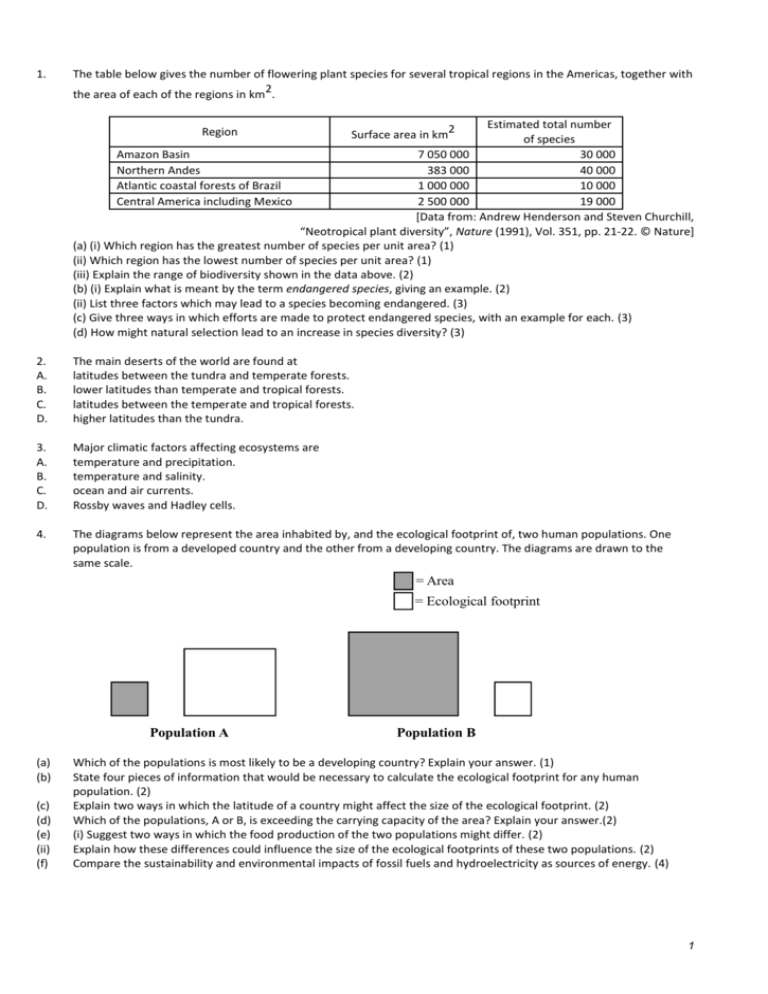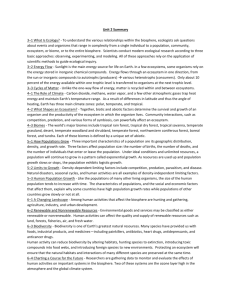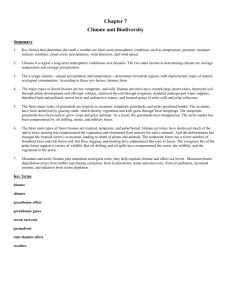Topic 2.4
advertisement

1. The table below gives the number of flowering plant species for several tropical regions in the Americas, together with 2 the area of each of the regions in km . Estimated total number of species Amazon Basin 7 050 000 30 000 Northern Andes 383 000 40 000 Atlantic coastal forests of Brazil 1 000 000 10 000 Central America including Mexico 2 500 000 19 000 [Data from: Andrew Henderson and Steven Churchill, “Neotropical plant diversity”, Nature (1991), Vol. 351, pp. 21-22. © Nature] (a) (i) Which region has the greatest number of species per unit area? (1) (ii) Which region has the lowest number of species per unit area? (1) (iii) Explain the range of biodiversity shown in the data above. (2) (b) (i) Explain what is meant by the term endangered species, giving an example. (2) (ii) List three factors which may lead to a species becoming endangered. (3) (c) Give three ways in which efforts are made to protect endangered species, with an example for each. (3) (d) How might natural selection lead to an increase in species diversity? (3) Region Surface area in km 2 2. A. B. C. D. The main deserts of the world are found at latitudes between the tundra and temperate forests. lower latitudes than temperate and tropical forests. latitudes between the temperate and tropical forests. higher latitudes than the tundra. 3. A. B. C. D. Major climatic factors affecting ecosystems are temperature and precipitation. temperature and salinity. ocean and air currents. Rossby waves and Hadley cells. 4. The diagrams below represent the area inhabited by, and the ecological footprint of, two human populations. One population is from a developed country and the other from a developing country. The diagrams are drawn to the same scale. = Area = Ecological footprint Population A (a) (b) (c) (d) (e) (ii) (f) Population B Which of the populations is most likely to be a developing country? Explain your answer. (1) State four pieces of information that would be necessary to calculate the ecological footprint for any human population. (2) Explain two ways in which the latitude of a country might affect the size of the ecological footprint. (2) Which of the populations, A or B, is exceeding the carrying capacity of the area? Explain your answer.(2) (i) Suggest two ways in which the food production of the two populations might differ. (2) Explain how these differences could influence the size of the ecological footprints of these two populations. (2) Compare the sustainability and environmental impacts of fossil fuels and hydroelectricity as sources of energy. (4) 1 5. A. B. C. D. A biome is a collection of ecosystems that contain the same species. a collection of ecosystems sharing similar climatic conditions. an ecosystem that is undergoing change. a collection of populations living and interacting with each other. 6. I. II. III. IV. The main factors that determine the type of biome found are temperature. precipitation. soil type. wind direction. A. B. C. D. I and II only I and III only I, II and IV only I, II, III and IV 7. A. B. C. D. Which combination of abiotic factors is typical of the tropical forest biome? Low insolation and high rainfall Wide range of temperatures and high rainfall Narrow range of temperatures and high rainfall High insolation and low rainfall 8. A. B. C. D. What is a biome? A collection of ecosystems sharing similar climatic conditions A group of populations living and interacting with each other in a common habitat A community of independent organisms and the physical environment they inhabit A group of organisms that interbreed and produce fertile offspring Net primary productivity / g m–2 yr–1 9. The graph below shows net primary productivity (NPP) of eight major biomes. 2500 2000 1500 1000 500 0 Tropical Deciduous Tropical Coniferous Agricultural Temperate grasslands rainforests forests grasslands forests land Tundra Deserts Biomes [D Waugh, Geography An Integrated Approach, (Nelson Thornes Ltd., 2000) p. 304. Reproduced by permission of Nelson Thornes Ltd.] (a) (i) Compare, and give reasons for, the differences in net primary productivity between any two biomes named in the graph. (4) (ii) State two of the main factors which influence productivity. (2) (b) Explain, with the aid of a diagram, the transfers and transformations of energy as it flows through an ecosystem.(7) (c) Compare the structure and distribution of tropical rainforests and tundra. (4) 2 10. I. II. III. A. B. C. D. Which statement(s) correctly describe the relative productivity of different biomes? The productivity of biomes always decreases with increasing distance from the equator. The productivity of biomes is directly proportional to the amount of solar energy they receive. The productivity of biomes is related to the prevailing climatic conditions at their latitude. I, II and III I and II only II and III only III only 11. Examine the photograph below of an ecosystem which has high temperatures all through the year. [Hjvannes, Cloud Forest Santa Lucia, Nanegal, Ecuador, licensed under the Creative Commons Attribution ShareAlike 3.0 License.] (a) State the type of ecosystem shown above. (1) (b) From the photograph, describe the structure of the ecosystem and explain the conditions that support it. (4) (c) Outline the global distribution of this type of ecosystem. (2) Which biome is usually found adjacent to ice-caps? Tundra Grassland Tropical rain forest Temperate forest 13. A. B. C. D. A collection of ecosystems sharing similar climatic conditions is a niche. community. habitat. biome. 14. The graphs below represent the average monthly precipitation and temperature in two biomes. 30 20 50 40 20 J F MAM J J A S ON D Month 40 30 20 10 (Freezing) 0 –10 20 10 –20 10 0 –30 0 Precipitation / cm 30 Temperature / °C 40 Precipitation / cm Temperature / °C 12. A. B. C. D. J F M AM J J A S O N D Month 3 Which of the following correctly identifies biomes X and Y? A. B. C. D. X Temperate forest Tropical rainforest Tropical rainforest Temperate forest Y Tundra Tundra Desert Desert 15. (a) The following graph shows the increase in total area of two types of protected habitats in a region of Africa between 1910 and 1990. 500 Key: grassland Total area protected / km 2 400 rainforest 300 200 100 1910 1930 190 1970 1990 Year [Adapted from J Sayer, C Harcourt and N Collin , The Conservation Atlas of Tropical Forests, Africa © 1992 Gale, a part of Cengage Learning, Inc. Reproduced by permission. www.cengage.com/permissions] (i) (ii) (iii) (iv) (b) Suggest two reasons why there might be a greater area of grassland protected than rainforest (2) Calculate the percentage increase in protected area for each of the two habitats over the last twenty years shown on the graph. (2) Suggest a possible reason for the difference between these percentage increases of protected area for the two habitats. (1) Explain the significance of the increase in protected rainforest to global biodiversity. (2) The diagram below represents the plan of a proposed nature reserve: Key: Transitionzone: - Human settlements of limitedsize. Bufferzone: - Scientific research. - Eco-tourism. - Sustainable exploitation by local residents. Corezone: - No human activity. Explain the benefits of each of these three zones for the purposes of conservation. (4) Transition zone Buffer zone Core zone 4 16. (a) (b) (c) “… because of human activities, habitats are disappearing faster than they can be studied, and simple stock-taking of threatened habitats is now an urgent task. It isn’t rational to use a treasure-chest for firewood until you’ve checked inside for treasure, yet this is what is happening to the Earth’s largely uncatalogued biological treasure-houses. Foremost among these are the tropical rainforests.” (Silvertown 1990) Outline the relative importance of tropical rainforests in contributing to global biodiversity, and explain why they have developed such high rates of biodiversity. (4) With reference to a named area of biological significance you have studied, explain how it has been or is being degraded by “human activities”. (8) Silvertown describes biodiversity as “treasure”. Discuss the ways in which biodiversity can be seen as a valuable resource to people. (5) 17. The data table below shows the nitrogen content of a temperate forest and a tropical forest. Table 1 –2 Nitrogen / gm Component Temperate forest Tropical forest Leaves 12.4 52.6 Wood* 18.5 41.2 Roots 18.4 28.2 Surface litter 40.9 3.9 Soil** 730.9 85.3 Total 821.1 211.2 * living wood only ** does not include roots [Source: Adapted from E P Odum, Fundamentals of Ecology, (1971), Saunders College Publishing, page 375] (ii) (b) (c) (d) (a) (i) Calculate the total nitrogen content in biomass (excluding surface litter) for temperate and tropical forests. (1) Calculate the percentage of total nitrogen present in biomass (excluding surface litter) for temperate and tropical forests. Give your answer to the nearest 0.1%. (1) Determine which of the two biomes contains a proportionally larger amount of nitrogen in its soil. Support your answer with appropriate calculations. (2) Suggest a possible explanation for the difference in nitrogen content in surface litter between the two biomes. (2) Using table 1, list the following ecosystem components, in terms of their importance as nitrogen storages, in ascending order: biomass, surface litter, soil. (1) Temperate forest: Tropical forest: (e) (f) (g) 1. ............................................................ 2. ............................................................ 3. ............................................................ 1. ............................................................ 2. ............................................................ 3. ............................................................ least important ↓ most important least important ↓ most important In terms of the impact on nitrogen storage, deduce which ecosystem would suffer more from clear-cut forestry practices (complete removal of all tree cover). Explain your answer. (2) Using the data in table 1, and your knowledge of biotic and abiotic conditions in tropical and temperate forests, explain which of the two biomes would be a better choice for growing crops. (2) Outline the impact of agriculture on biodiversity. (3) Table 2: Population and economic data for Malaysia Year Population / millions GNP per capita US$ 1980 13.10 1815 1985 15.21 2100 1992 17.98 3062 1993 18.41 3312 1994 18.85 3655 1995 19.28 4310 1996 19.72 4795 1997 20.49 4563 Gross National Product (GNP) per capita is the value of a country’s final output of goods and services in a year, divided by its population. It gives an indication of a country’s economic strength. 5 Graph 1: Changes in forested land in Malaysia (1960–1997) 10000 100 90 9000 Area of forested land / ha 80 area of forested land 8000 70 Proportion of land forested / % 7000 60 6000 proportion of land forested 5000 1960 1965 1970 1975 50 1980 1985 1990 40 1997 Year [Source: Adapted from A Kidd, Managing Ecosystems, (1999), Hodder and Stoughton, page 41, and The World Bank, http://www.worldbank.org/data/gdf/PDF/mys.pdf] (ii) (iii) (iv) 18. (h) (i) Using the data above, state the relationship between population and forested area in Malaysia. (1) Using the data above, suggest a reason for the decrease in the area of forested land. (1) Explain how the reduction of forested area contributes to global warming. (2) Outline the effect of increased mean global temperature on biomes. (2) Figure 1 and Figure 2 below are cartoons which each express an environmental message. Figure 1 [Source: Cummings, Winnipeg Free Press, CartoonArts International] (a) Suggest what message the cartoonist is trying to depict about attitudes to environmental problems in Figure 1. (2) 6 Figure 2 [Source: DeAngelis, Rome, Italy, CartoonArts International] (b) (b) (c) (b) (c) Figure 2 is a cartoon which suggests that a conflict exists between resource use and the needs of indigenous people. Explain why such a conflict might exist in tropical rainforests. (3) 19. (a) Discuss how gross productivity, net productivity and diversity will change over time as a habitat goes through succession. Illustrate your answer with a named case study. (5) Explain the present distribution of desert and tundra and discuss the factors controlling their relative productivity. (6) Outline the components of an Environmental Impact Assessment (EIA) and justify your personal viewpoint on the value of EIAs in the environmental decision making process. Refer to a specific EIA in your answer. (7) 20. (a) Outline the process of photosynthesis and explain how different limiting factors will determine productivity in two contrasting biomes. (4) Suggest why agreement has not yet been reached on the role of human activity in global warming. Justify what measures you think a named country should adopt in response to the threat of climate change. (8) Identify two landmarks in the development of the modern environmental movement, and justify why each one is significant. (6) 7






